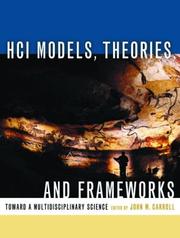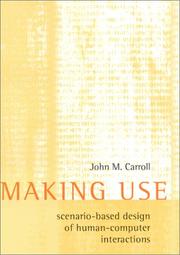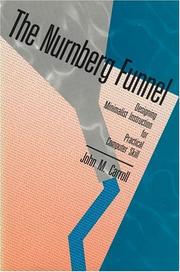| Listing 1 - 10 of 71 | << page >> |
Sort by
|
Book
ISBN: 0716716879 9780716716877 Year: 1985 Publisher: New York
Abstract | Keywords | Export | Availability | Bookmark
 Loading...
Loading...Choose an application
- Reference Manager
- EndNote
- RefWorks (Direct export to RefWorks)
Lexicology. Semantics --- Psycholinguistics --- 800:159.9 --- Onomasiology --- Language, Psychology of --- Language and languages --- Psychology of language --- Speech --- Linguistics --- Psychology --- Thought and thinking --- Naming (Semantics) --- Nomination (Semantics) --- Semantics --- Semiotics --- Taalwetenschap. Taalkunde. Linguistiek-:-Psychologie: zie ook: Psychiatrie: n-{616.89-008} en n-{615.851} --- Psychological aspects --- Onomasiology. --- Psycholinguistics. --- 800:159.9 Taalwetenschap. Taalkunde. Linguistiek-:-Psychologie: zie ook: Psychiatrie: n-{616.89-008} en n-{615.851}

ISBN: 0674029232 0674017013 9780674017016 9780674029231 Year: 2005 Publisher: Cambridge, Mass. London, Eng. Harvard University Press
Abstract | Keywords | Export | Availability | Bookmark
 Loading...
Loading...Choose an application
- Reference Manager
- EndNote
- RefWorks (Direct export to RefWorks)
In Edge of Empires, Carroll situates Hong Kong squarely within the framework of both Chinese and British colonial history, while exploring larger questions about the meaning and implications of colonialism in modern history.
Regions & Countries - Asia & the Middle East --- History & Archaeology --- East Asia --- Hong Kong (China) --- China --- History. --- History --- 1861-1912 --- Republic,1912-1949 --- S27/0500 --- Hong Kong--History: general and before 1949 --- HISTORY / Asia / China.
Book
ISBN: 3319036556 3319036564 Year: 2014 Publisher: Cham : Springer International Publishing : Imprint: Springer,
Abstract | Keywords | Export | Availability | Bookmark
 Loading...
Loading...Choose an application
- Reference Manager
- EndNote
- RefWorks (Direct export to RefWorks)
University teaching and learning has never been more innovative than it is now. This has been enabled by a better contemporary understanding of teaching and learning. Instructors now present situated projects and practices to their students, not just foundational principles. Lectures and structured practice are now often replaced by engaging and constructivist learning activities that leverage what students know about, think about, and care about. Teaching innovation has also been enabled by online learning in the classroom, beyond the classroom, and beyond the campus. Learning online is perhaps not the panacea sometimes asserted, but it is a disruptively rich and expanding set of tools and techniques that can facilitate engaging and constructivist learning activities. It is becoming the new normal in university teaching and learning. The opportunity and the need for innovation in teaching and learning are together keenest in information technology itself: Computer and Information Science faculty and students are immersed in innovation. The subject matter of these disciplines changes from one year to the next; courses and curricula are in constant flux. And indeed, each wave of disciplinary innovation is assimilated into technology tools and infrastructures for teaching new and emerging concepts and techniques. Innovative Practices in Teaching Information Sciences and Technology: Experience Reports and Reflections describes a set of innovative teaching practices from the faculty of Information Sciences and Technology at Pennsylvania State University. Each chapter is a personal essay describing practices, implemented by one or two faculty, that challenge assumptions, and push beyond standard practice at the individual faculty and classroom level. These are innovations that instructors elsewhere may find directly accessible and adaptable. Taken as a set, this book is a case study of teaching innovation as a part of faculty culture. Innovation is not optional in information technology; it inheres in both the disciplinary subject matter and in teaching. But it is an option for instructors to collectively embrace innovation as a faculty. The chapters in this book, taken together, embody this option and provide a partial model to faculties for reflecting on and refining their own collective culture of teaching innovation.
College teaching. --- Computer science. --- Education. --- Information technology -- Study and teaching (Higher). --- Science_xStudy and teaching. --- Information technology --- College teaching --- Electrical & Computer Engineering --- Engineering & Applied Sciences --- Information Technology --- Study and teaching (Higher) --- Computer science --- Study and teaching. --- Informatics --- IT (Information technology) --- Education --- Science education. --- Teaching. --- Computer Science. --- Computers and Education. --- Teaching and Teacher Education. --- Science Education. --- Data processing. --- Science --- Technology --- Telematics --- Information superhighway --- Knowledge management --- Science education --- Scientific education --- Children --- Education, Primitive --- Education of children --- Human resource development --- Instruction --- Pedagogy --- Schooling --- Students --- Youth --- Civilization --- Learning and scholarship --- Mental discipline --- Schools --- Teaching --- Training --- Education—Data processing. --- Didactics --- School teaching --- Schoolteaching --- Instructional systems --- Pedagogical content knowledge

ISBN: 1558608087 9781558608085 9786611007201 128100720X 0080491413 9780080491417 9781281007209 6611007202 Year: 2003 Publisher: San Francisco, Calif. Morgan Kaufmann
Abstract | Keywords | Export | Availability | Bookmark
 Loading...
Loading...Choose an application
- Reference Manager
- EndNote
- RefWorks (Direct export to RefWorks)
Finally a thorough pedagogical survey of the multidisciplinary science of HCI. Human-Computer Interaction spans many disciplines, from the social and behavioral sciences to information and computer technology. But of all the textbooks on HCI technology and applications, none has adequately addressed HCI's multidisciplinary foundations until now. HCI Models, Theories, and Frameworks fills a huge void in the education and training of advanced HCI students. Its authors comprise a veritable house of diamonds internationally known HCI researchers, every one of whom has successfully applied a unique scientific method to solve practical problems. Each chapter focuses on a different scientific analysis or approach, but all in an identical format, especially designed to facilitate comparison of the various models. HCI Models, Theories, and Frameworks answers the question raised by the other HCI textbooks: How can HCI theory can support practice in HCI? * Traces HCI research from its origins * Surveys 14 different successful research approaches in HCI * Presents each approach in a common format to facilitate comparisons * Web-enhanced with teaching tools at http://www.HCImodels.com *Contributors are leading researchers in the field of Human-Comptuter Interaction *Fills a major gap in current literature about the rich scientific foundations of HCI *Provides a thorough pedogological survey of the science of HCI
Human-computer interaction. --- 159.95*1 --- 371.694 --- 371.694 Geprogrammeerde instructie. CAI. Leermachines. Computerbegeleid onderwijs. --- Geprogrammeerde instructie. CAI. Leermachines. Computerbegeleid onderwijs. --- 159.95*1 Cognitieve psychologie --- Cognitieve psychologie --- Human-computer interaction --- Computer-human interaction --- Human factors in computing systems --- Interaction, Human-computer --- Human engineering --- User-centered system design --- User interfaces (Computer systems) --- Geprogrammeerde instructie. CAI. Leermachines. Computerbegeleid onderwijs --- Information Technology --- General and Others --- Human engineering. --- Ergonomics --- Human factors in engineering design --- Bioengineering --- Environmental engineering --- Industrial engineering --- Human comfort --- Human-robot interaction

ISBN: 0262269929 1423742036 9780262269926 9780262513883 9780262032797 0262032791 Year: 2000 Publisher: Cambridge, Mass. MIT Press
Abstract | Keywords | Export | Availability | Bookmark
 Loading...
Loading...Choose an application
- Reference Manager
- EndNote
- RefWorks (Direct export to RefWorks)
"Difficult to learn and awkward to use, today's information systems often change our activities in ways that we do not need or want. The problem lies in the software development process. In this book John Carroll shows how a pervasive but underused element of design practice, the scenario, can transform information systems design.Traditional textbook approaches manage the complexity of the design process via abstraction, treating design problems as if they were composites of puzzles. Scenario-based design uses concretization. A scenario is a concrete story about use. For example: "A person turned on a computer; the screen displayed a button labeled Start; the person used the mouse to select the button." Scenarios are a vocabulary for coordinating the central tasks of system development--understanding people's needs, envisioning new activities and technologies, designing effective systems and software, and drawing general lessons from systems as they are developed and used. Instead of designing software by listing requirements, functions, and code modules, the designer focuses first on the activities that need to be supported and then allows descriptions of those activities to drive everything else.In addition to a comprehensive discussion of the principles of scenario-based design, the book includes in-depth examples of its application."
Human-computer interaction. --- Human-computer interaction --- Engineering & Applied Sciences --- Computer Science --- Computer-human interaction --- Human factors in computing systems --- Interaction, Human-computer --- Human engineering --- User-centered system design --- User interfaces (Computer systems) --- COMPUTER SCIENCE/Human Computer Interaction --- Computer software --- Human factors --- Computer software - Human factors

ISBN: 9027934479 9783110825619 3110825619 9789027934475 Year: 1980 Volume: 55 Publisher: The Hague New York Mouton Publishers
Abstract | Keywords | Export | Availability | Bookmark
 Loading...
Loading...Choose an application
- Reference Manager
- EndNote
- RefWorks (Direct export to RefWorks)
Toward a Structural Psychology of Cinema Approaches to Semiotics [AS]
Motion pictures --- Semiotics. --- Philosophy. --- Psycholinguistics --- Film --- Semiotics --- #SBIB:309H526 --- 791.41 --- film --- film en psychologie --- film en semiotiek --- filmtheorie --- John M. Carroll --- psychologie --- 316.77 --- Semeiotics --- Semiology (Linguistics) --- Semantics --- Signs and symbols --- Structuralism (Literary analysis) --- 316.77 Communicatiesociologie --- Communicatiesociologie --- Philosophy --- Psychologie van de audiovisuele boodschap

ISBN: 0262269945 0585348626 9780585348629 0262031639 9780262031639 9780262269940 Year: 1990 Publisher: Cambridge, Mass. MIT Press
Abstract | Keywords | Export | Availability | Bookmark
 Loading...
Loading...Choose an application
- Reference Manager
- EndNote
- RefWorks (Direct export to RefWorks)
Electronic data processing --- Engineering & Applied Sciences --- Computer Science --- Study and teaching --- Semantics (Philosophy). --- Semantics. --- Lerarenopleiding --- Study and teaching. --- (vak)didactiek wetenschappen.
Book
ISBN: 1108893279 9781108893275 9781108789776 1108789773 1108899501 1108897002 Year: 2022 Publisher: Cambridge Cambridge University Press
Abstract | Keywords | Export | Availability | Bookmark
 Loading...
Loading...Choose an application
- Reference Manager
- EndNote
- RefWorks (Direct export to RefWorks)
The Occupy Central/Umbrella Movement of 2014 and the anti-extradition protests of 2019 revealed how much Hong Kong's relationship with mainland China has deteriorated since the former British colony returned to Chinese sovereignty in July 1997. With mutual distrust and suspicion at an all-time high, many Hong Kong people have become increasingly hostile toward the Chinese government and the mainland in general, identifying themselves as Hongkongers rather than as Chinese. Yet, as John Carroll shows, for more than 150 years, colonial Hong Kong and China not only coexisted with but benefited each other, even during the anti-imperialist campaigns of the Republican and Communist eras. The porous boundary between Hong Kong and China enabled the two to use each other economically, politically, socially, and culturally. The Hong Kong-China nexus, although firmly embedded in global dynamics of colonialism, Cold War politics, and capitalist expansion, defies many common assumptions about nationalism, colonialism, and decolonization.
Nationalism --- Regionalism --- Hong Kong (China) --- China --- Relations --- Human geography --- Interregionalism --- International relations --- Patriotism --- Political science --- Autonomy and independence movements --- Internationalism --- Political messianism --- Consciousness, National --- Identity, National --- National consciousness --- National identity --- Cina --- Kinë --- Cathay --- Chinese National Government --- Chung-kuo kuo min cheng fu --- Republic of China (1912-1949) --- Kuo min cheng fu (China : 1912-1949) --- Chung-hua min kuo (1912-1949) --- Kina (China) --- National Government (1912-1949) --- China (Republic : 1912-1949) --- People's Republic of China --- Chinese People's Republic --- Chung-hua jen min kung ho kuo --- Central People's Government of Communist China --- Chung yang jen min cheng fu --- Chung-hua chung yang jen min kung ho kuo --- Central Government of the People's Republic of China --- Zhonghua Renmin Gongheguo --- Zhong hua ren min gong he guo --- Kitaĭskai︠a︡ Narodnai︠a︡ Respublika --- Činská lidová republika --- RRT --- Republik Rakjat Tiongkok --- KNR --- Kytaĭsʹka Narodna Respublika --- Jumhūriyat al-Ṣīn al-Shaʻbīyah --- RRC --- Kitaĭ --- Kínai Népköztársaság --- Chūka Jinmin Kyōwakoku --- Erets Sin --- Sin --- Sāthāranarat Prachāchon Čhīn --- P.R. China --- PR China --- PRC --- P.R.C. --- Chung-kuo --- Zhongguo --- Zhonghuaminguo (1912-1949) --- Zhong guo --- Chine --- République Populaire de Chine --- República Popular China --- Catay --- VR China --- VRChina --- 中國 --- 中国 --- 中华人民共和国 --- Jhongguó --- Bu̇gu̇de Nayiramdaxu Dundadu Arad Ulus --- Bu̇gu̇de Nayiramdaqu Dumdadu Arad Ulus --- Bu̇gd Naĭramdakh Dundad Ard Uls --- BNKhAU --- БНХАУ --- Khi︠a︡tad --- Kitad --- Dumdadu Ulus --- Dumdad Uls --- Думдад Улс --- Kitajska --- China (Republic : 1949- ) --- Hong Kong Special Administrative Region (China) --- Xiang gang te bie xing zheng qu (China) --- 香港特別行政區 (China) --- Zhonghua Renmin Gongheguo Xianggang Tebie Xingzhengqu --- Chung-hua jen min kung ho kuo Hsiang-kang tʻe pieh hsing cheng chʻü --- Zhong hua ren min gong he guo Xiang gang te bie xing zheng qu --- 中華人民共和國香港特別行政區 --- HKSAR (China) --- Hsiang-kang tʻe pieh hsing cheng chʻü (China) --- Xianggang (China) --- 香港 (China) --- Xianggang Tebie Xingzhengqu (China) --- Hong Kong S.A.R. (China) --- Hong Kong
Book
Year: 1962 Publisher: New York (N.Y.): McGraw-Hill,
Abstract | Keywords | Export | Availability | Bookmark
 Loading...
Loading...Choose an application
- Reference Manager
- EndNote
- RefWorks (Direct export to RefWorks)
Book
Year: 1957 Publisher: New York (N.Y.): McGraw-Hill,
Abstract | Keywords | Export | Availability | Bookmark
 Loading...
Loading...Choose an application
- Reference Manager
- EndNote
- RefWorks (Direct export to RefWorks)
| Listing 1 - 10 of 71 | << page >> |
Sort by
|

 Search
Search Feedback
Feedback About UniCat
About UniCat  Help
Help News
News